Games are a fantastic way to bring people together. They encourage interaction, break the ice, and create fun, shared experiences. Whether you are planning a family reunion, a large birthday celebration, or simply looking for weekend entertainment for a crowd, having a repertoire of engaging games is always a great idea. This list focuses on games perfect for family reunions and other large gatherings, ensuring everyone, from kids to grandparents, can join in the fun. Get ready to explore some exciting games and discover a new favorite for your next get-together!
Exciting Games for Large Groups
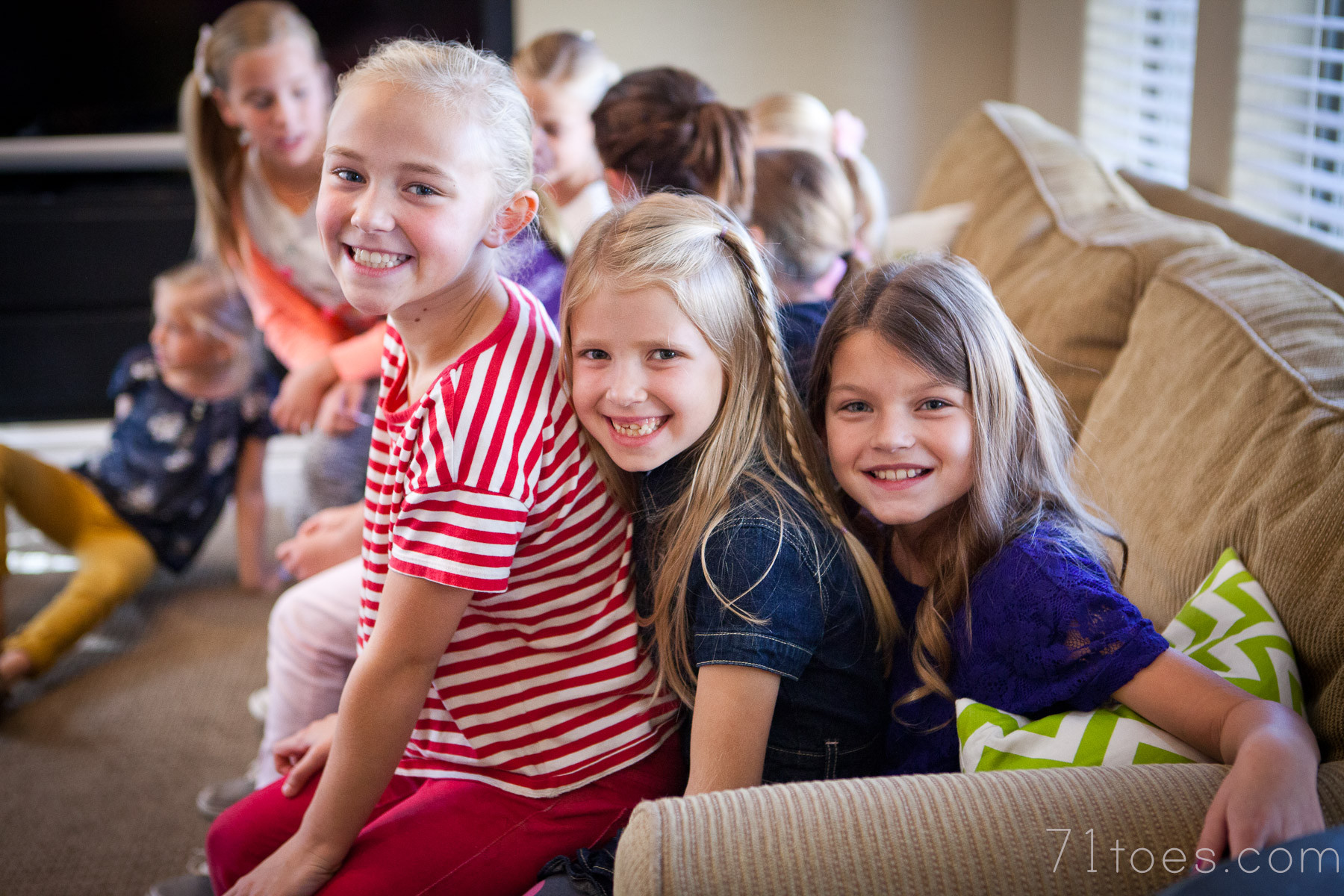
Three-Deep: The Matching Mayhem
Objective: Find your two “counterparts” by matching themed slips of paper.
How to Play:
- Prepare Slips: Create slips of paper with sets of three related items. Examples include:
- Colors: red, blue, green
- Disney Princesses: Snow White, Cinderella, Sleeping Beauty
- Animals: dog, cat, bird
- Fruits: apple, banana, orange
- Distribute and Mingle: Give each person a slip of paper. Before starting, have everyone mingle and swap papers to mix them up thoroughly.
- Find Your Match: When someone yells “go!”, participants shout out the item on their paper and try to find the two people who have matching items. For example, if you have “red,” you’ll look for “blue” and “green.”
- Three-Deep Seating: Once a group of three finds each other, they sit down together in a “three-deep” line, designated by letters (B, M, T for bottom, middle, top) assigned beforehand to each set.
- Elimination: The last groups to find their match are out. Continue playing rounds until only one group of three remains.
Why it’s great for family reunions: Three-Deep is energetic, encourages communication, and gets everyone moving and interacting. The matching element is simple enough for all ages to grasp, making it a perfect icebreaker game.
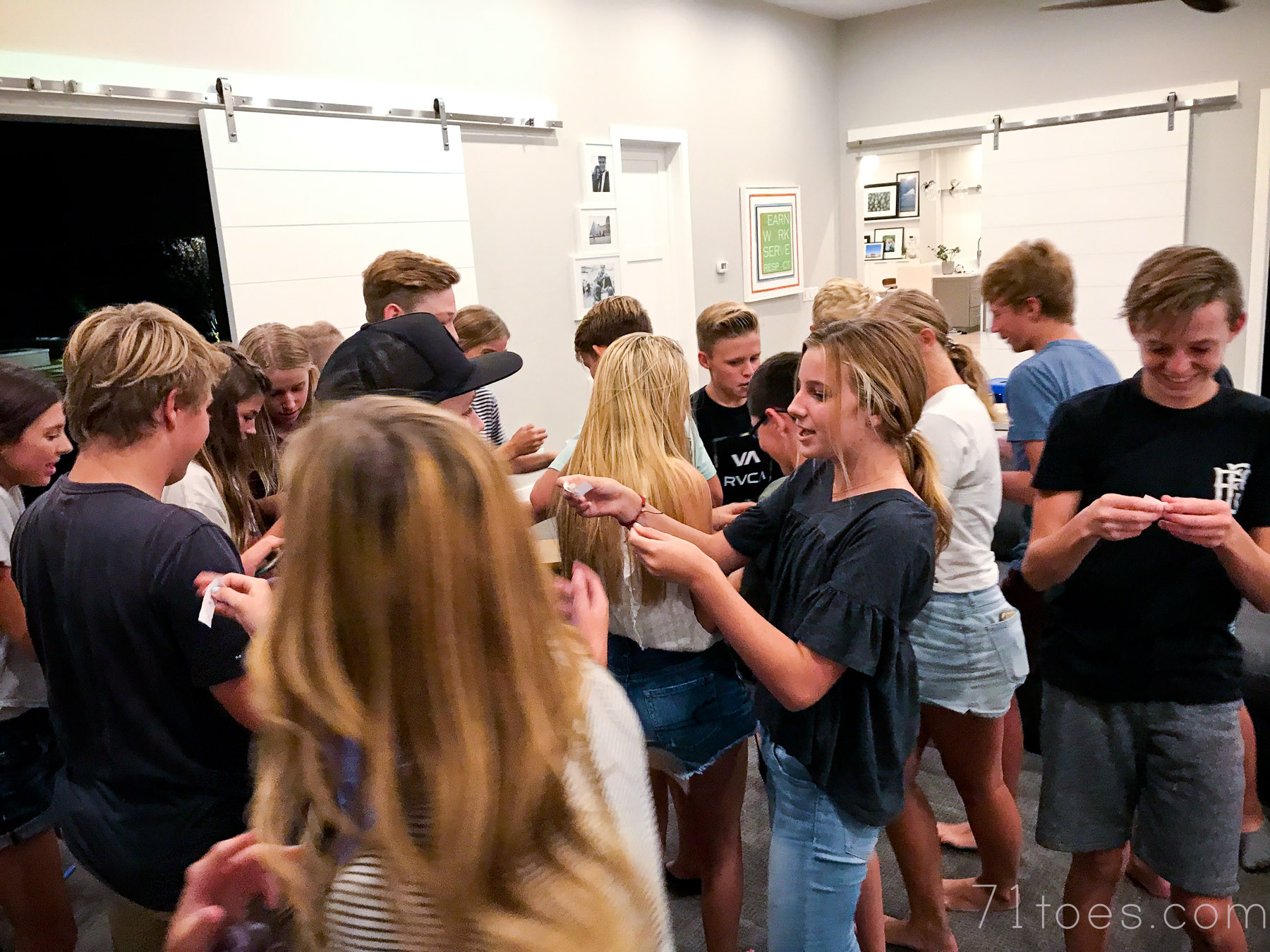
Penny Game: Chance, Guessing, and Hilarious Consequences
Objective: Avoid being the last person “in” and facing a funny consequence.
How to Play:
- Coin Collection: Each player starts with three coins (or any small, similar items).
- Consequence Agreement: Before starting, the group decides on a funny consequence for the loser. Examples:
- Silly dares
- Performing a song
- Doing chores
- A funny face in cake (as in the original example)
- Hidden Coins: Players put their hands behind their backs and secretly transfer 0-3 coins into their right fist.
- Guessing Round: Players take turns guessing the total number of coins in everyone’s outstretched fists. No one can guess the same number, and rotate who guesses first each round.
- Reveal and Count: Everyone reveals their fists, and the coins are counted.
- Elimination by Closest Guess: The person who guessed closest to the actual number is “out” and becomes a spectator.
- Last One Loses: Repeat rounds, eliminating one player each time, until only one person remains – the loser who faces the consequence!
Why it’s great for family reunions: The Penny Game requires minimal equipment, can be played anywhere, and is full of suspense and laughter. The anticipation of the consequence and the guessing element keep everyone engaged and entertained.
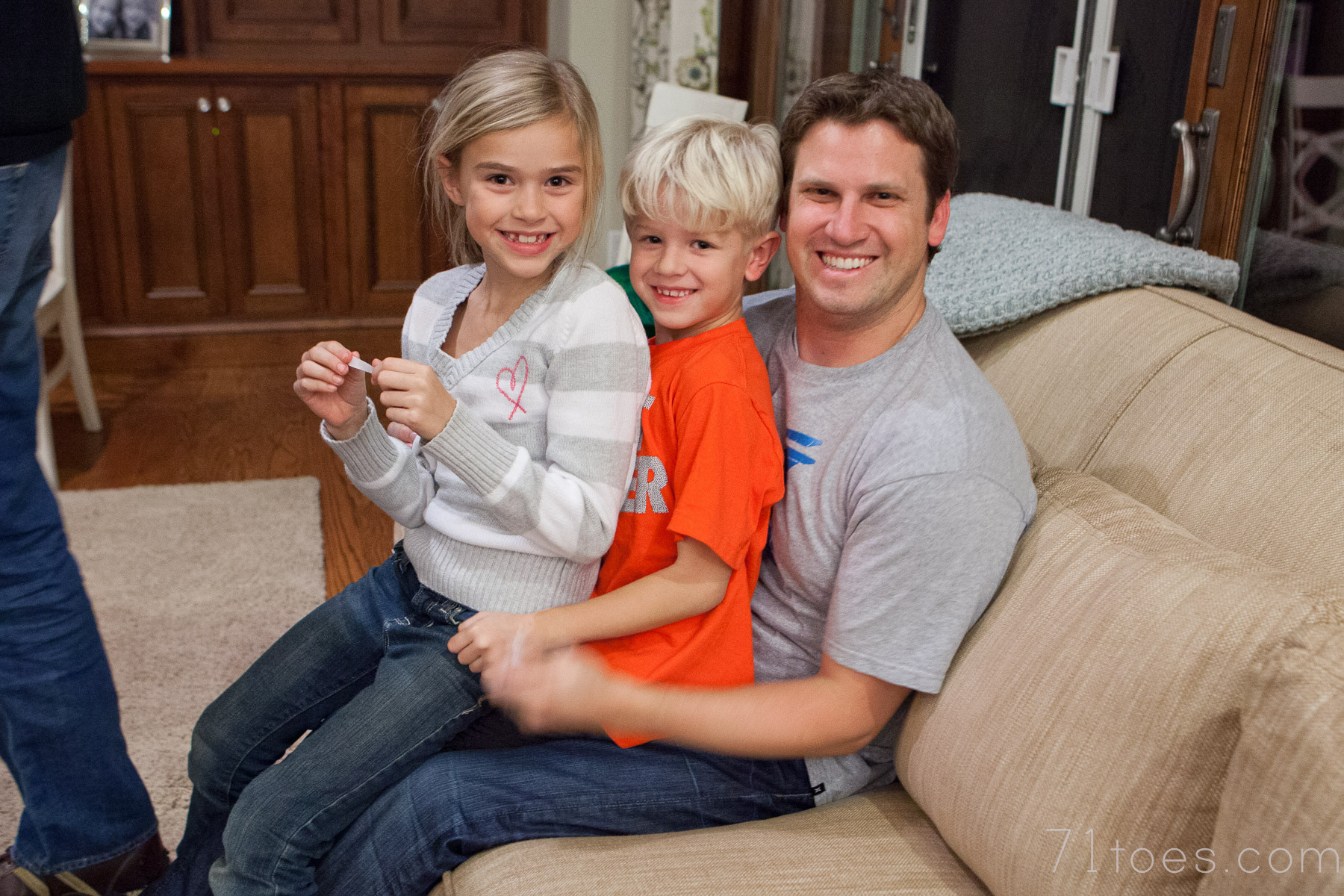
Animals: Sound Imitation and Blindfolded Fun
Objective: The blindfolded person in the center must guess who is making an animal sound.
How to Play:
- Circle Formation: Have everyone stand in a circle.
- Blindfolded Center: One person is blindfolded and stands in the middle of the circle.
- Spin and Point: Spin the blindfolded person gently so they lose their orientation. They then point to someone in the circle.
- Animal Sound Challenge: The person pointed at must make an animal sound of their choice, disguising their voice as much as possible.
- Guessing Game: The blindfolded person tries to guess who made the sound.
- Incorrect Guess: If the guess is wrong, everyone claps once, and the blindfolded person points to someone else.
- Correct Guess: If the guess is correct, the person who made the animal sound becomes the new blindfolded person in the center.
Why it’s great for family reunions: Animals is a simple yet hilarious game that encourages creativity and listening skills. The voice disguises and animal sounds lead to funny moments and shared laughter, perfect for intergenerational fun.
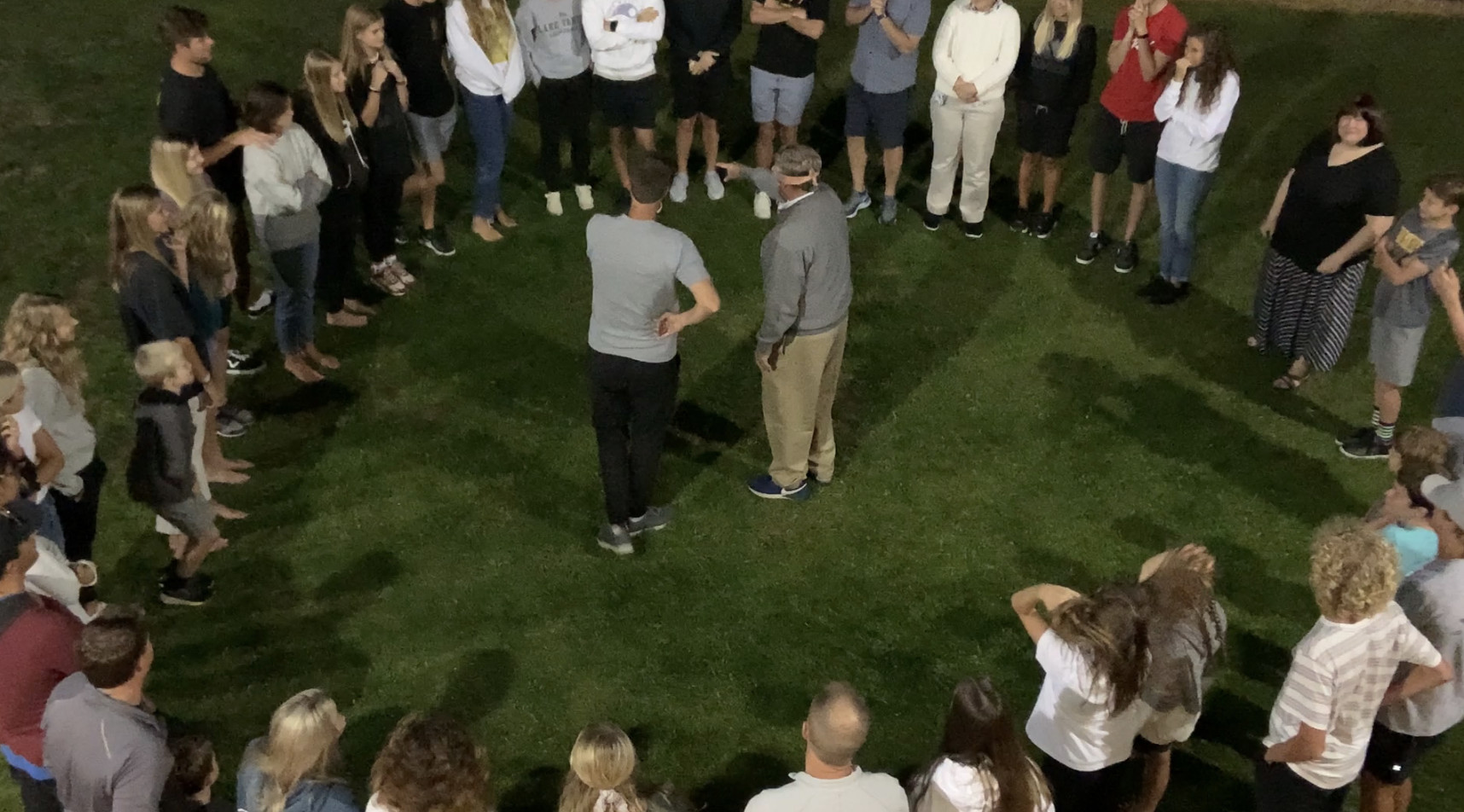
Minute-to-Win-It Games: Fast-Paced Challenges
Minute-to-Win-It games are perfect for adding a high-energy, competitive element to your family reunion. These quick challenges are easy to set up and provide instant entertainment.
1) Cheetos Catch: Shaving Cream Head Challenge
Objective: Catch as many Cheetos on shaving cream covered heads as possible in one minute.
How to Play:
- Shaving Cream Prep: Have one representative from each team generously cover their head in shaving cream.
- Cheeto Throwers: Another representative from each team stands a set distance away with a bowl of Cheetos.
- Minute of Catching: On “go,” the throwers toss Cheetos, and the shaving cream heads try to catch as many as they can within one minute.
- Count the Catch: After one minute, count the number of Cheetos stuck to each shaving cream head. The team with the most Cheetos wins.
Why it’s great for family reunions: Cheetos Catch is incredibly silly and visually funny, guaranteeing lots of laughs. It’s a memorable, messy, and highly entertaining minute-to-win-it game.
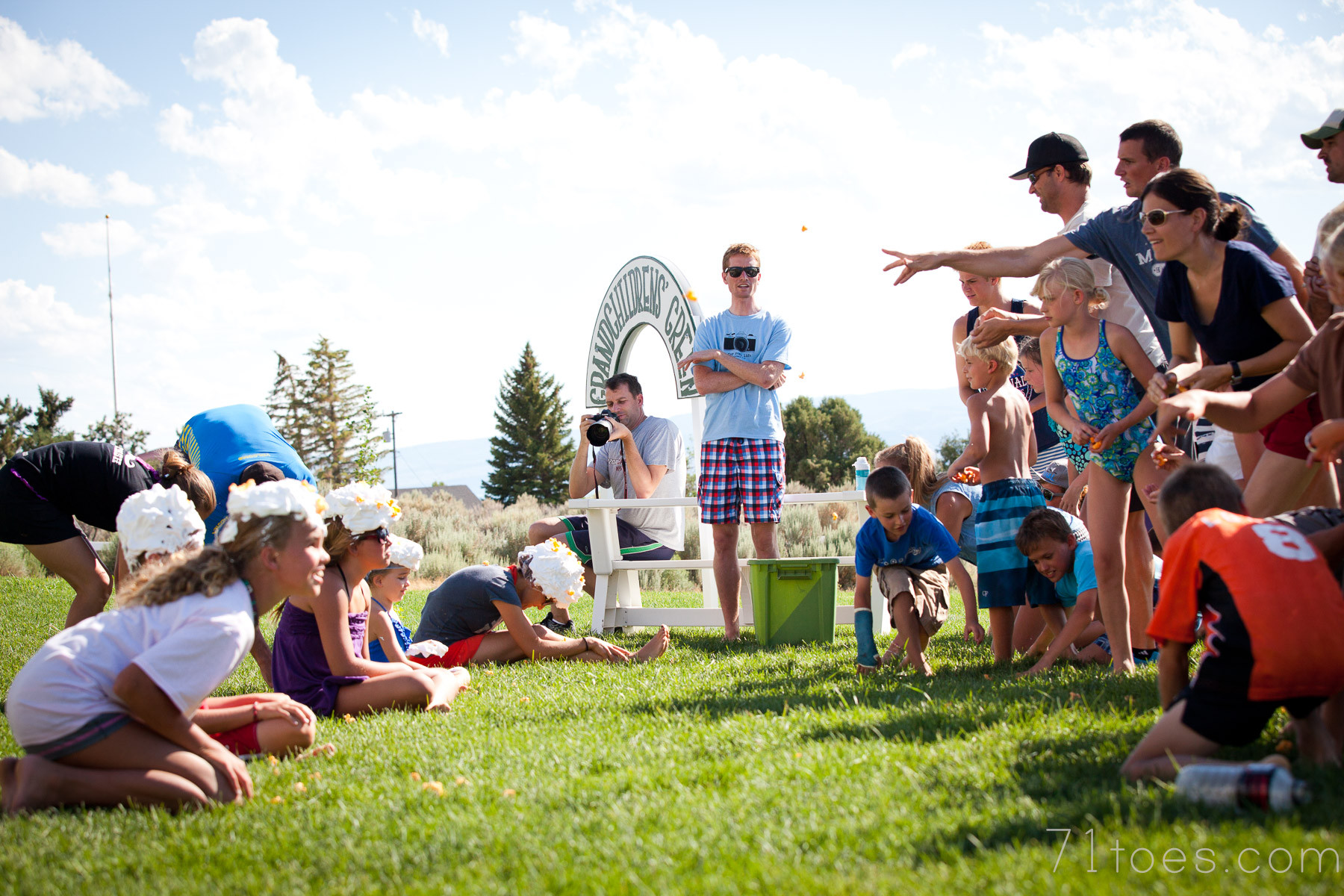
Warning: Be prepared for some shaving cream messiness! This game often devolves into playful shaving cream fights, adding to the fun.

2) Shake-It: Ping Pong Ball Box Challenge
Objective: Be the first to shake all ping pong balls out of a tissue box strapped to your waist in one minute.
How to Play:
- Box Prep: Fill empty Kleenex boxes with a set number of ping pong balls (e.g., 8-10).
- Waist Belts: Secure a tissue box around the waist of each competitor using a belt or string, with the opening facing downwards.
- Shake to Win: On “go,” competitors must shake, wiggle, and jump to empty their boxes of all ping pong balls within one minute, without using their hands.
- First to Empty Wins: The first person to empty their box completely wins the round.
Why it’s great for family reunions: Shake-It is active, competitive, and hilarious to watch. The combination of physical challenge and the funny sight of people shaking tissue boxes makes it a crowd-pleaser.
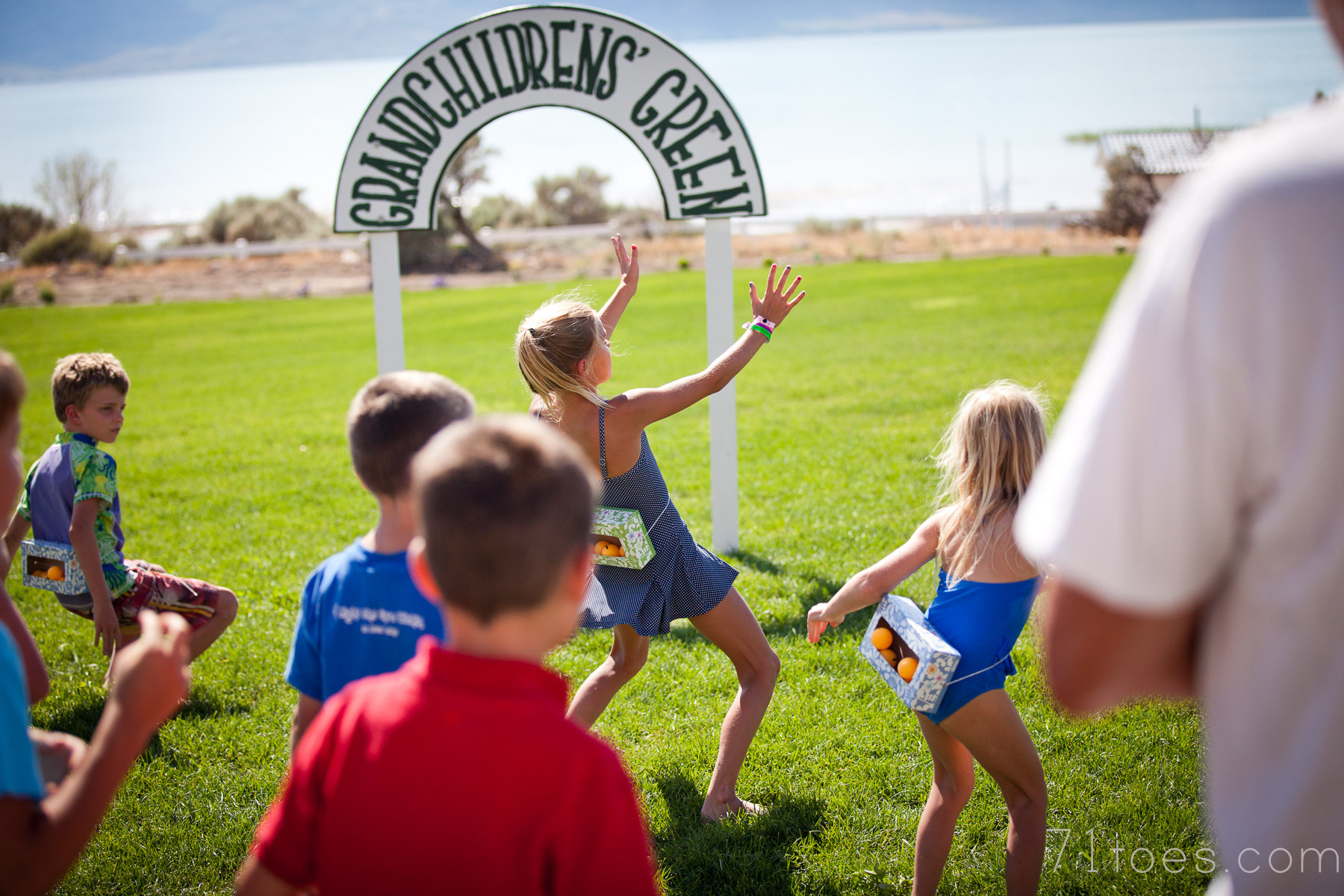
Reverse Charades: Team Acting Fun
Objective: Guess as many words as possible acted out by your team in a limited time.
How to Play:
- Team Division: Divide into teams.
- Word Selection: Use a Reverse Charades app or prepare word slips in a basket.
- Actor and Guesser: One person from each team is the “guesser” and faces away from the acting team.
- Team Acting: The rest of the team sees a word and acts it out together silently.
- Guessing Time: The guesser has a set time (e.g., 1 minute) to guess as many words as possible based on their team’s simultaneous acting.
- Word Cycling: Once a word is guessed, the next word is shown to the acting team.
- Score Keeping: Teams get points for each correctly guessed word. The team with the most points at the end wins.
Why it’s great for family reunions: Reverse Charades is inclusive, engaging for all ages, and generates uproarious laughter, especially when family members get creative with their acting. It promotes teamwork and quick thinking.
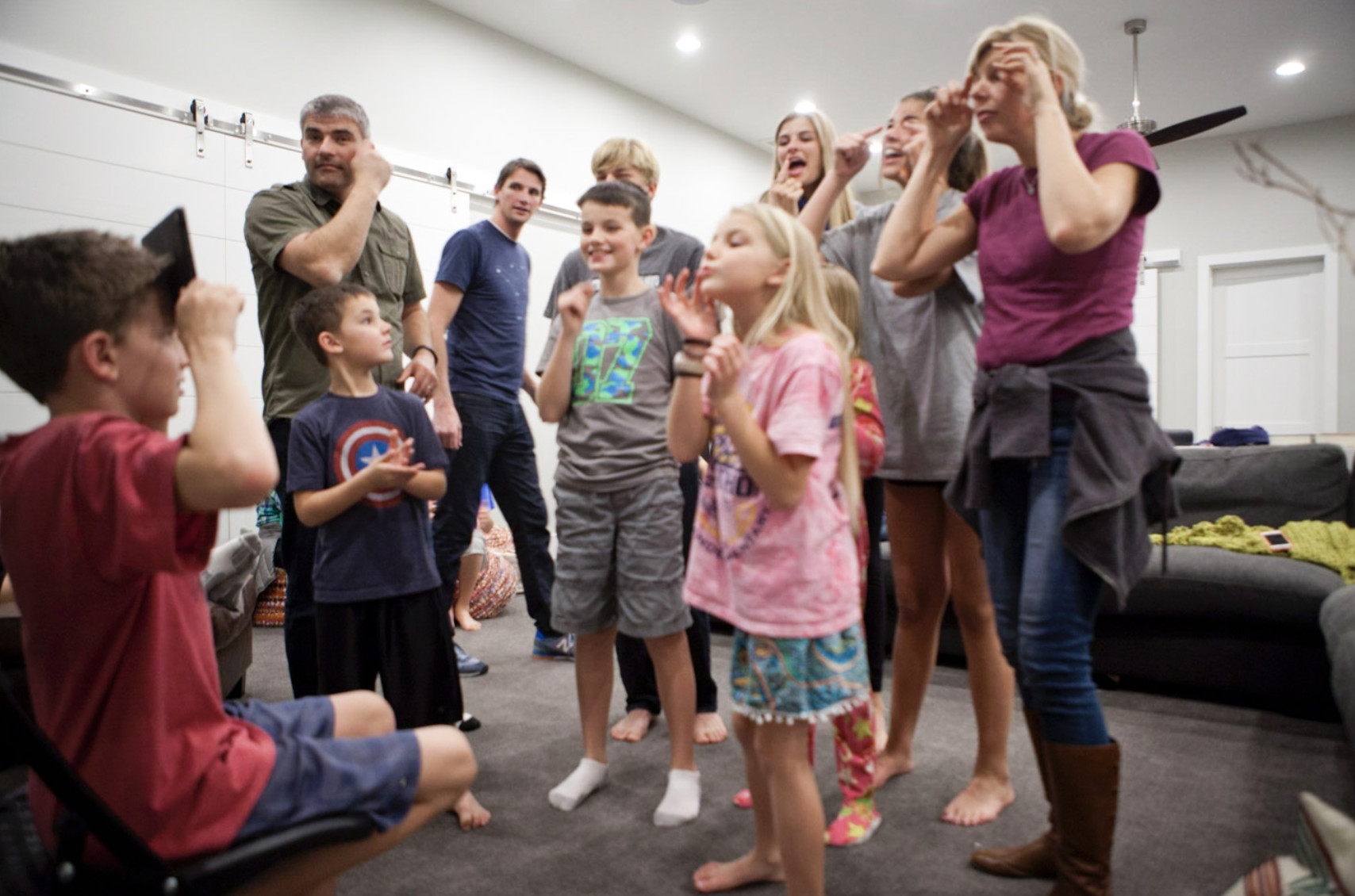
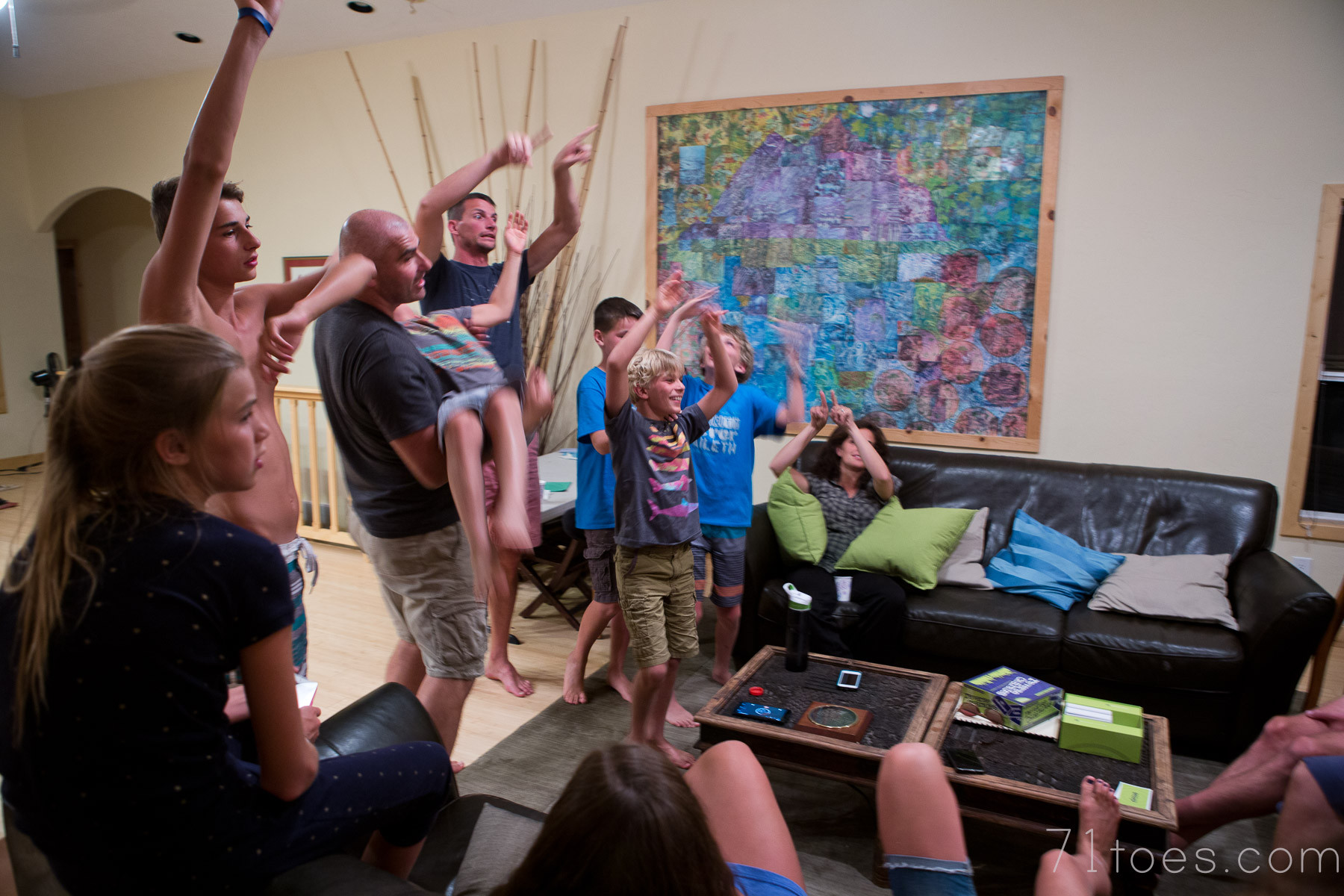
Fear Factor: Taste Testing Challenges
Objective: Be the last one willing to taste increasingly challenging (and sometimes unpleasant) foods.
How to Play:
- Food Prep: Gather a variety of foods, ranging from mild to “fear factor” level. Examples include:
- Mild: Green olives, lemon juice
- Medium: Pickled eggs, strong cheese
- Extreme: Anchovies, crickets, unusual textures
- Tasting Rounds: Present a food item to all participants in each round.
- The Taste Test: Participants must eat or drink the offered item to advance to the next round. No water to wash it down!
- Elimination by Refusal: Those who refuse to taste or cannot swallow the food are eliminated.
- Fear Factor Champion: The last person remaining who is willing to taste all the challenges is the Fear Factor winner!
Why it’s great for family reunions: Fear Factor is a unique and adventurous game that can be surprisingly fun, especially for kids (and brave adults!). It encourages trying new things and creates hilarious reactions and memorable moments.
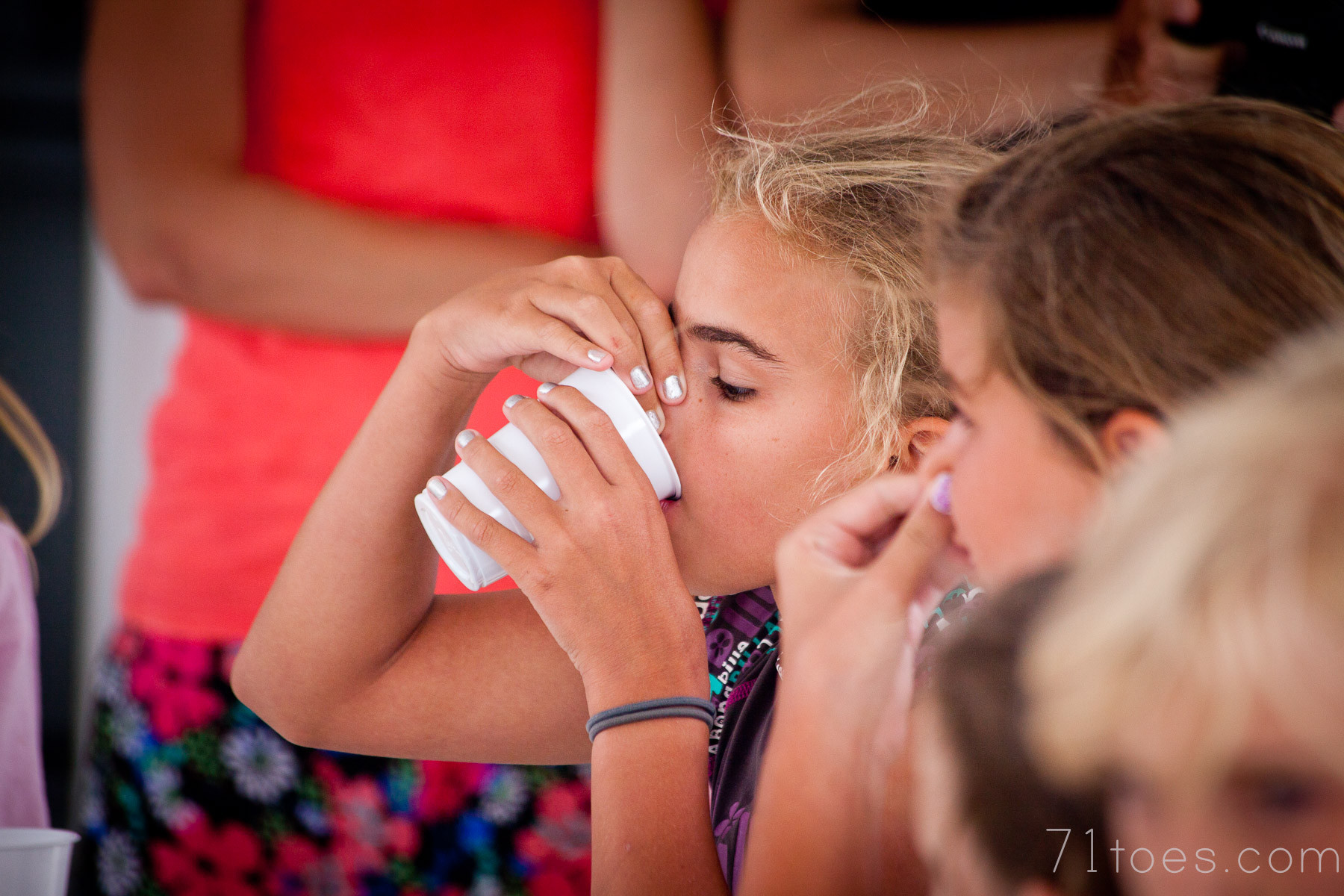
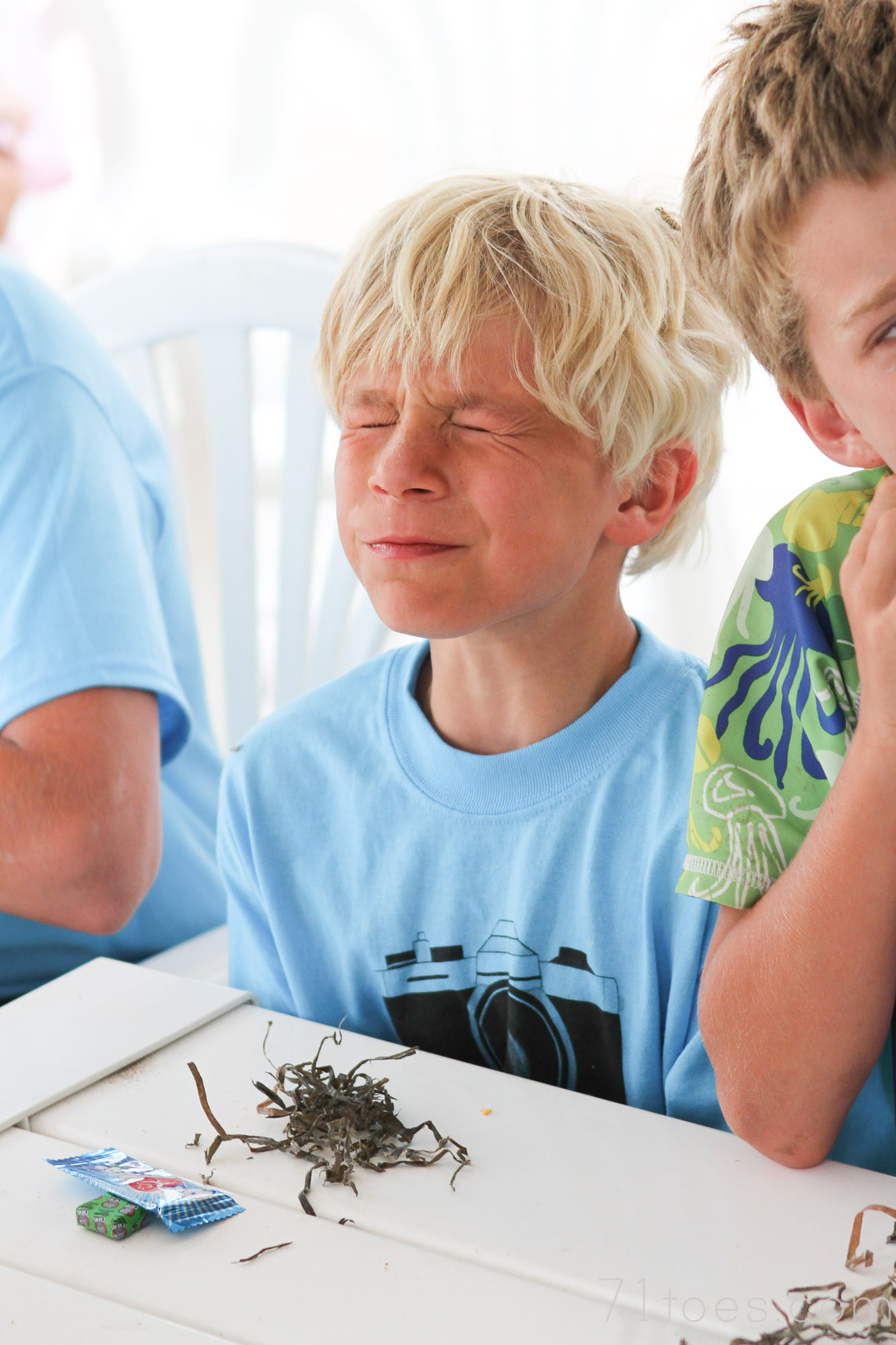
Triggers: Secret Action Game
Objective: Guess the “triggers” – secret actions that prompt specific responses from other players.
How to Play:
- Secret Trigger Setting: One person leaves the room. The remaining group assigns “triggers” to each person in the circle (or some designated players). A trigger is an action (e.g., someone folds arms, laughs, touches hair). Each trigger is linked to a specific reaction for another person (e.g., yell “bananas!”, crawl, hug the person in the middle).
- Guesser Returns: The person who left the room returns to the center.
- Trigger Observation: The guesser observes the group, trying to identify the triggers by noticing actions and reactions.
- Guess the Trigger: The guesser tries to figure out the action-reaction pairs (the triggers).
Why it’s great for family reunions: Triggers is a clever and funny game that requires observation and deduction. The secret reactions and the guesser’s attempts to figure them out create a lot of amusement for everyone involved.

Rock, Paper, Scissors Race: Active and Competitive
Objective: Be the first team to have all members cross to the opposite side of the playing area by winning Rock, Paper, Scissors matches.
How to Play:
- Team Lines: Divide into two teams and have them line up on opposite sides of a playing area, with lines marked for hopping.
- Hopping Start: The first person from each team starts hopping down the lines towards the opposing team’s line.
- Rock, Paper, Scissors Challenge: When two opposing players meet in the middle, they play Rock, Paper, Scissors.
- Winner Advances, Loser Retreats: The winner continues hopping towards the opposite side. The loser goes back to the end of their team’s line to try again later.
- Team Victory: The first team to get all of its members to the opposite side wins.
Why it’s great for family reunions: Rock, Paper, Scissors Race combines the classic game with physical activity and team competition. It’s exciting to watch and participate in, particularly for energetic family members.
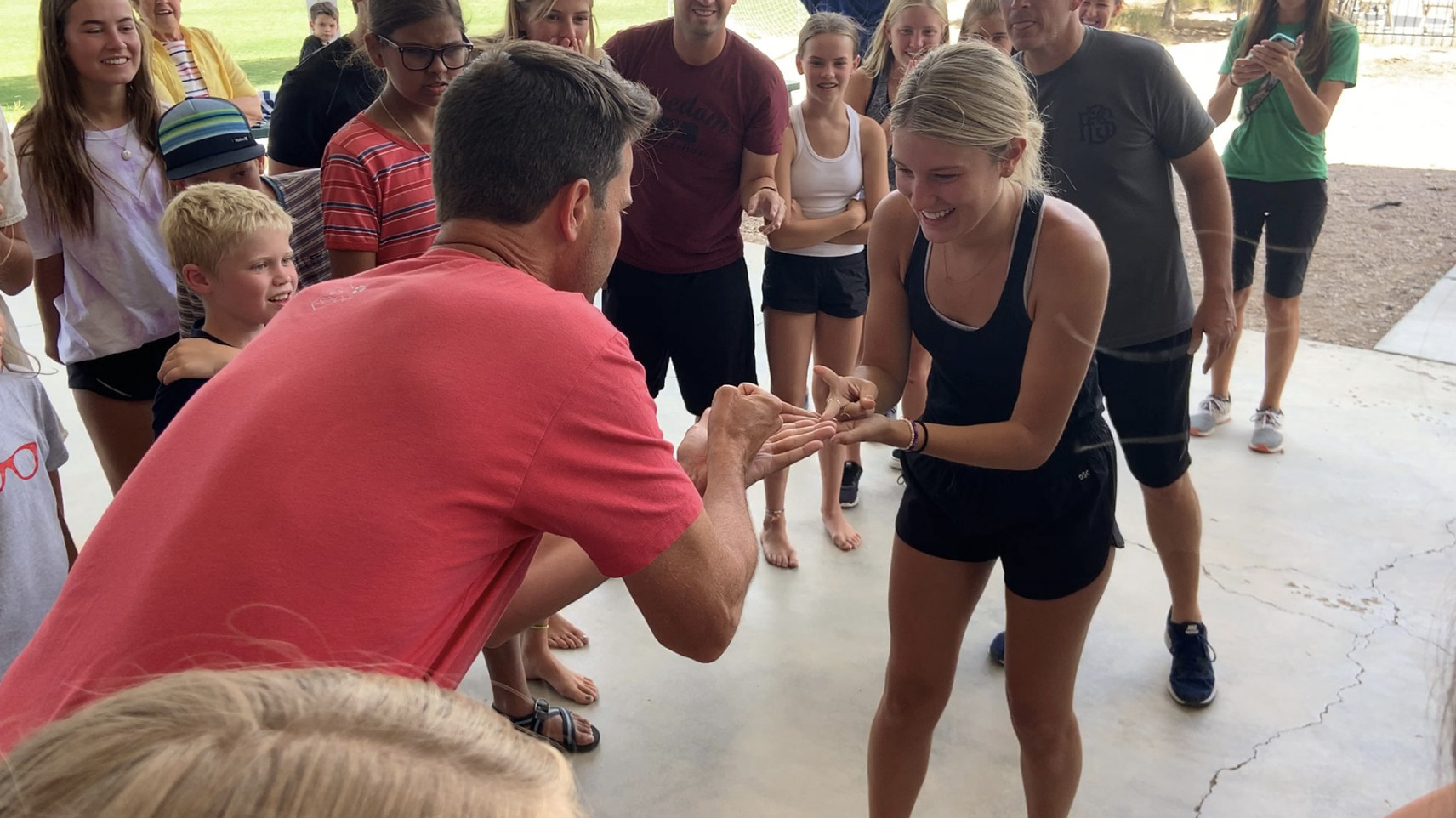
Psychiatrist: Mind-Reading Deduction
Objective: The “psychiatrist” must figure out the secret system the group is using to answer questions.
How to Play:
- Psychiatrist Out: One person leaves the room to be the “psychiatrist.”
- System Selection: The remaining group decides on a system for answering questions. Examples:
- Alphabetical order: Answers must start with letters in alphabetical order (A, B, C…).
- Character Imitation: Answer like a specific family member or famous person.
- Action-Based: Answer and slyly perform a specific action (e.g., touch hair).
- Psychiatrist In: The psychiatrist returns and asks questions to the group.
- System Deduction: The psychiatrist listens to the answers and observes the group’s behavior to try to figure out the secret answering system.
Why it’s great for family reunions: Psychiatrist is a classic game of deduction and wit that is always engaging. The creativity of the answering systems and the psychiatrist’s attempts to crack the code provide mental stimulation and laughs.
Little Sally Walker: Simple and Sweet
Objective: Follow the actions of “Little Sally Walker” and then become the leader yourself.
How to Play:
- Circle and Song: Everyone stands in a circle and sings the “Little Sally Walker” song.
- Walker’s Dance: One person (“Little Sally Walker”) skips around inside the circle while everyone sings.
- Stop and Choose: When the song ends (“…put your hand upon your hip”), Little Sally Walker stops in front of someone in the circle.
- Dance Imitation: Little Sally Walker does a simple dance in front of that person.
- Repeat and New Walker: The chosen person must copy the dance exactly, and then they become the new “Little Sally Walker” for the next round.
Why it’s great for family reunions: Little Sally Walker is a simple, traditional game perfect for younger children and intergenerational groups. It’s easy to learn, involves singing and movement, and is a sweet and gentle way to include everyone.
Sentimental Family Reunion Game Ideas:
For a more heartwarming and reflective reunion activity, consider these sentimental game ideas:
Family Stories: Guess the Storyteller
Objective: Guess who wrote a funny or memorable family story from a collection of anonymous submissions.
How to Play:
- Story Submission: Before the reunion (or at the start), have family members write down a short, funny, or memorable story about something that happened to them growing up.
- Story Reading: One person acts as the “reader” and reads each story aloud anonymously.
- Guessing Round: After each story, the reader randomly chooses a few people to elaborate and improvise details, trying to convince everyone they wrote the story.
- Voting: Everyone votes on who they think actually wrote the story.
- Points and Winner: Points are awarded for correct guesses. The person with the most points at the end of all stories wins.
Why it’s great for family reunions: Family Stories is a wonderful way to share memories, learn new things about each other, and reminisce about funny family moments. The guessing element adds an engaging twist to storytelling.
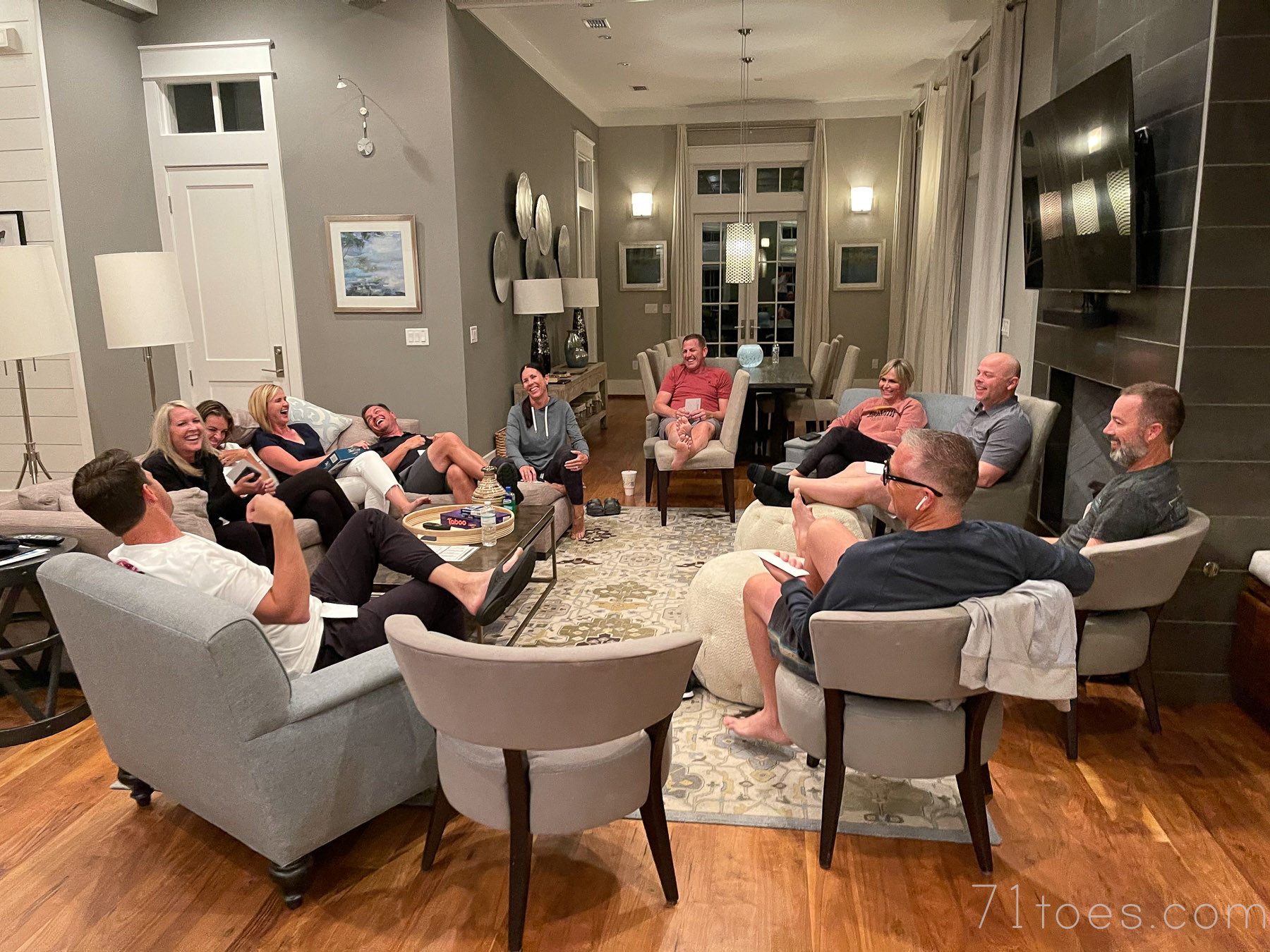
Family Trivia: Testing Family Knowledge
Objective: Guess which family member a story is about from a collection of submitted anecdotes.
How to Play:
- Story Collection: Before the game, have family members submit interesting or funny stories from their lives.
- Trivia Reading: A designated person reads the stories aloud, keeping the author anonymous.
- Guess the Family Member: Participants guess which family member the story is about.
- Story Elaboration: After the guesses, the actual person the story is about reveals themselves and can share more details.
Why it’s great for family reunions: Family Trivia is a fun way to test family knowledge and celebrate individual experiences. It encourages active listening and learning about different family members’ lives and histories.
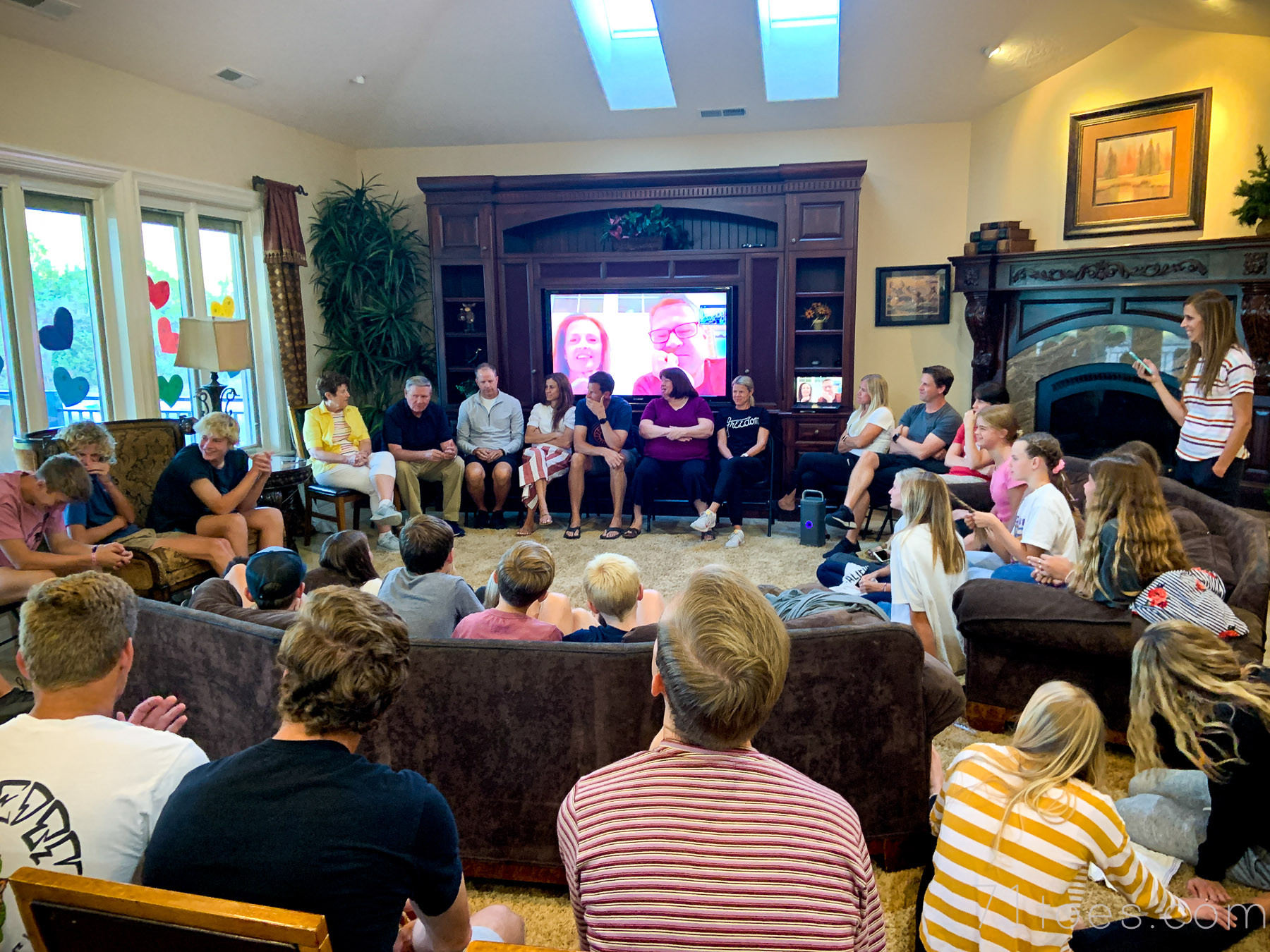
Classic Big-Group Games/Activities:
For simple, timeless fun, these classic games and activities are always a hit at family reunions:
Classic Slip-N-Slide: Watery Fun
Set up a slip-n-slide on a grassy hill using a large plastic sheet, water, and dish soap for a refreshing and exhilarating activity for all ages (with appropriate supervision for younger children).
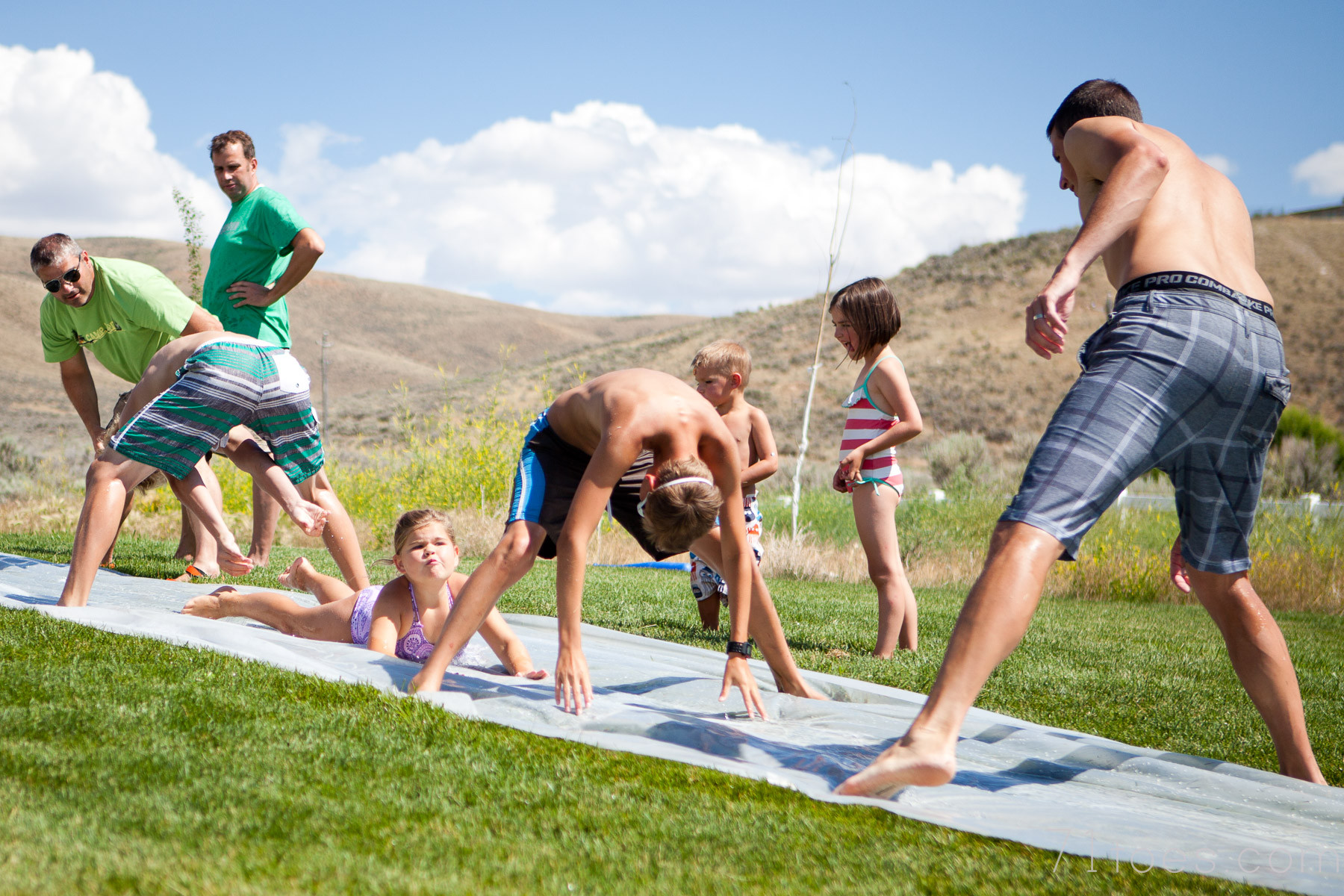
Relays: Races of All Kinds
Organize relay races in various formats for different age groups, adding friendly competition and physical activity to the reunion:
- Age-Category Relays: Traditional races divided by age groups.
- Piggy-Back Races: Fun partner relays where one person carries another.


- Three-Legged Races: Classic races where partners run with legs tied together.
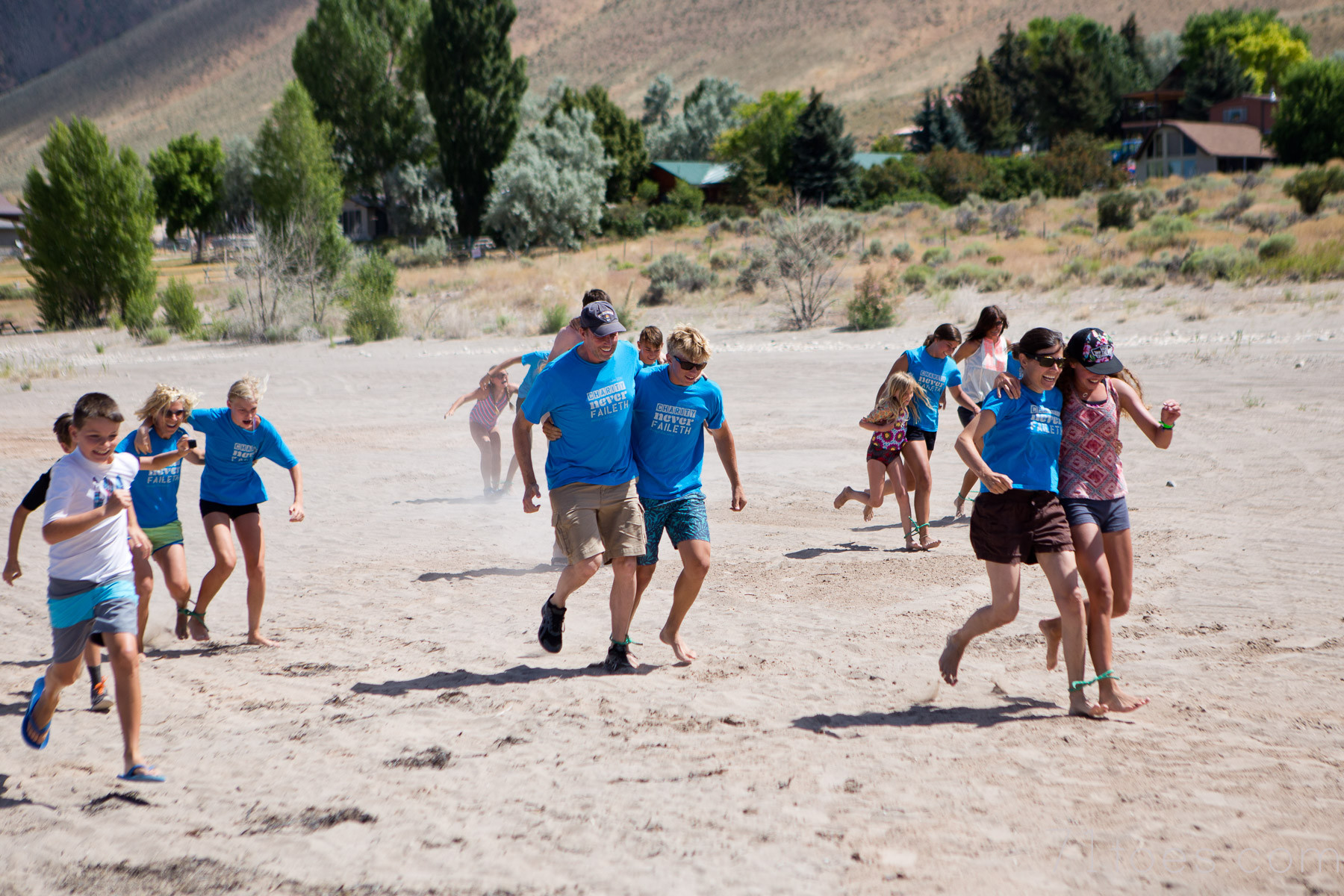
- Gunny Sack Races: Hilarious races where participants hop in sacks.
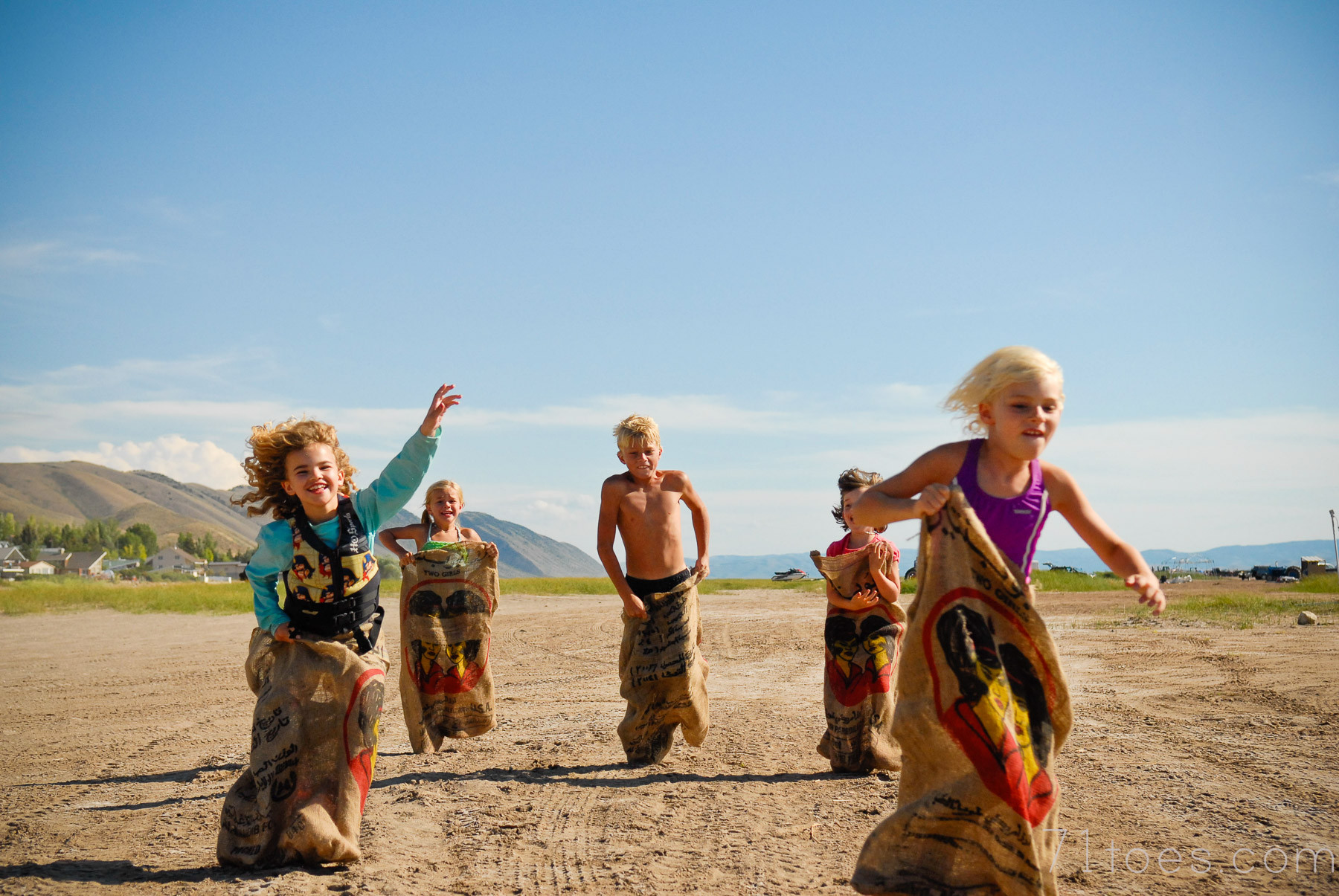
- Team Relay Races: Complex relays with multiple legs and tasks, ending with a fun reward like ice cream.

Water Balloon Toss: Cool-Down Fun
A classic summer game, divide into teams and see which team can toss water balloons back and forth the most times without breaking them.
Photo Scavenger Hunt: Exploration and Creativity
Organize a photo scavenger hunt, either in a specific location like a park or around the reunion venue. Provide teams with a list of photo challenges (e.g., “bird in flight,” “everyone jumping,” “artistic shot of the sky”) to capture creatively.
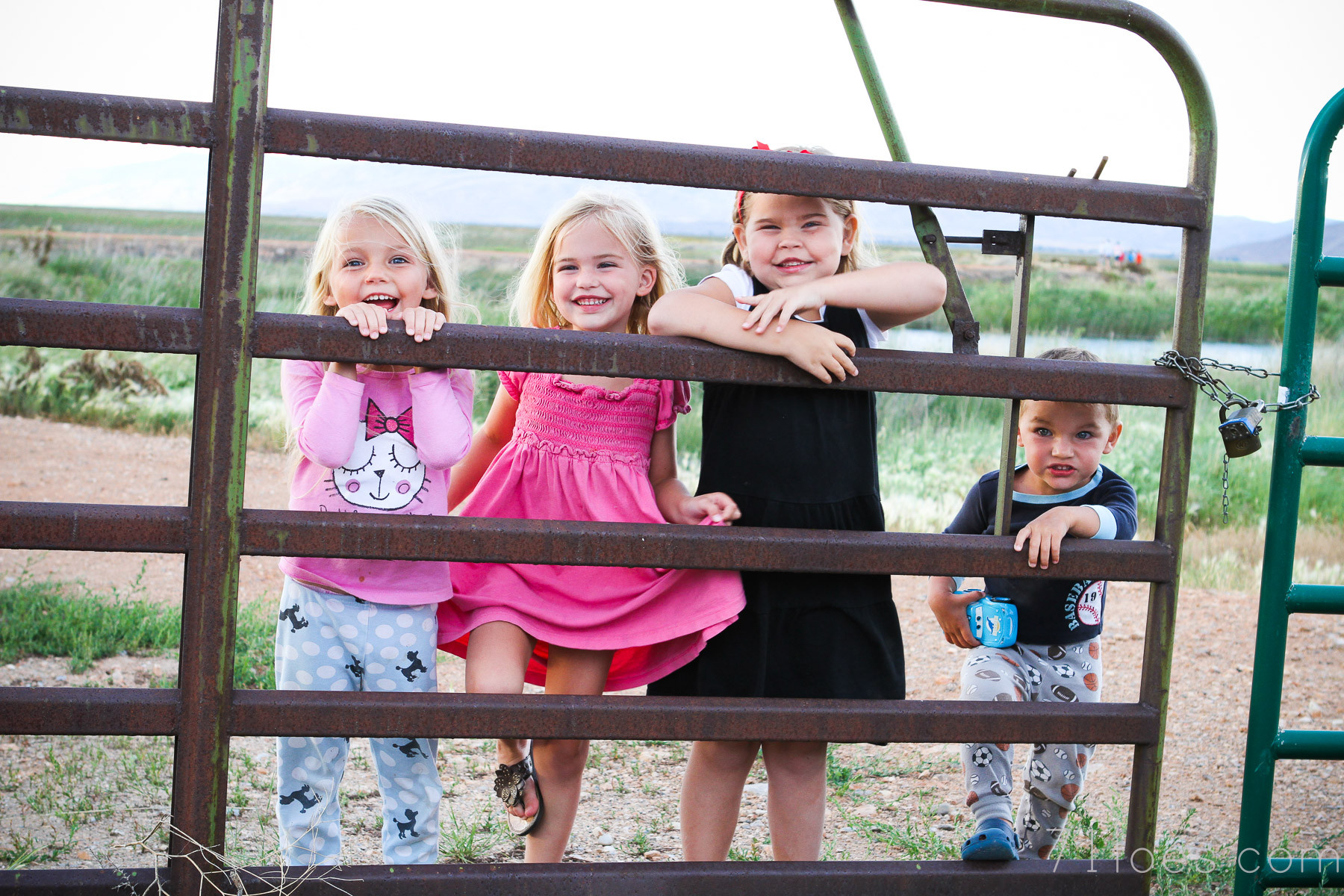
Example Scavenger Hunt List:

Steal the Bacon: Competitive Chase Game
Objective: Be the first from your team to grab “the bacon” (an object in the center) when your number is called.
How to Play:
- Team Lines and Numbers: Divide into two teams and have them line up on opposite sides of a field. Assign numbers to each player on each team.
- Bacon in the Middle: Place an object (“the bacon”) in the center of the field.
- Number Call: The host calls out a number.
- The Chase: The players with that number from each team race to the center to grab the “bacon.”
- Point Award: The team whose player grabs the bacon first gets a point.
- Winning Team: The team with the most points after several rounds wins.
Why it’s great for family reunions: Steal the Bacon is a fast-paced, competitive game that is exciting to play and watch, especially for families with a competitive spirit.
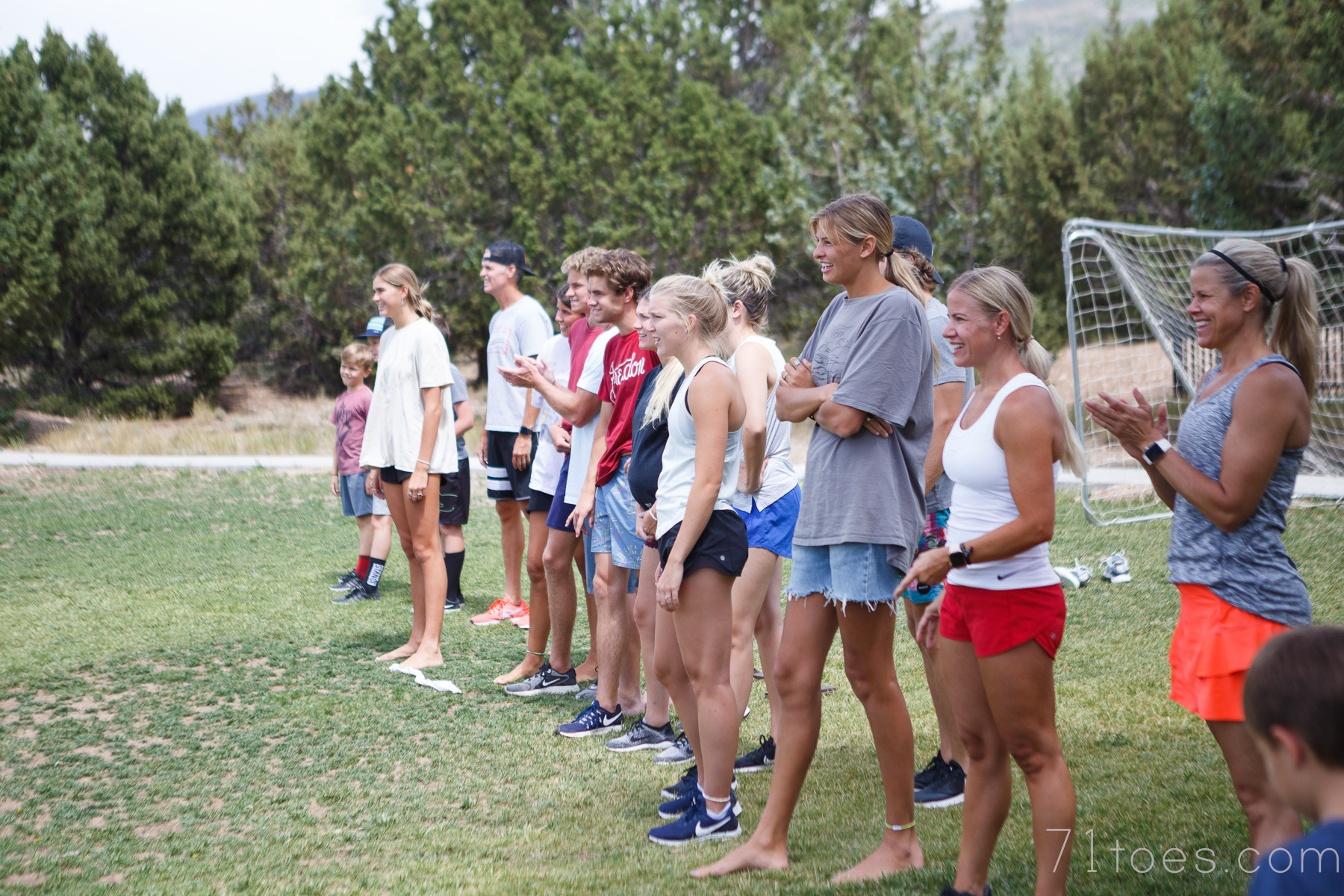
One and Done: Dice Rolling Gamble
Objective: Accumulate points by rolling a die, but risk losing all points for the round if a “one” is rolled.
How to Play:
- Scorecards: Each player gets a scorecard with three rows of 1-10 for ten rounds per game.
- Prize and Consequence: Agree on a prize for the winner and a funny consequence for the loser.
- Dice Rolling Rounds: Players take turns rolling a single die. The score accumulates with each roll (e.g., roll a 3, score is 3; next roll a 6, score is 9).
- Double with a Two: Rolling a “two” doubles the current score.
- Risk of a One: Rolling a “one” ends the round, and anyone still “in” gets zero points for that round.
- Opting Out: Players can choose to “opt out” at any time during a round and record the current score for that round.
- Three Rounds Total: Play three rounds of ten rolls each.
- Score Tally and Winner: After three rounds, players tally their scores. The highest score wins the prize, and the lowest score faces the consequence.
Why it’s great for family reunions: One and Done is a simple dice game with an element of strategy and risk. The suspense of rolling a “one” and the decision of when to “opt out” make it engaging and entertaining for all ages.



From hilarious consequences to fun prizes, One and Done is sure to create memorable moments at your family reunion.
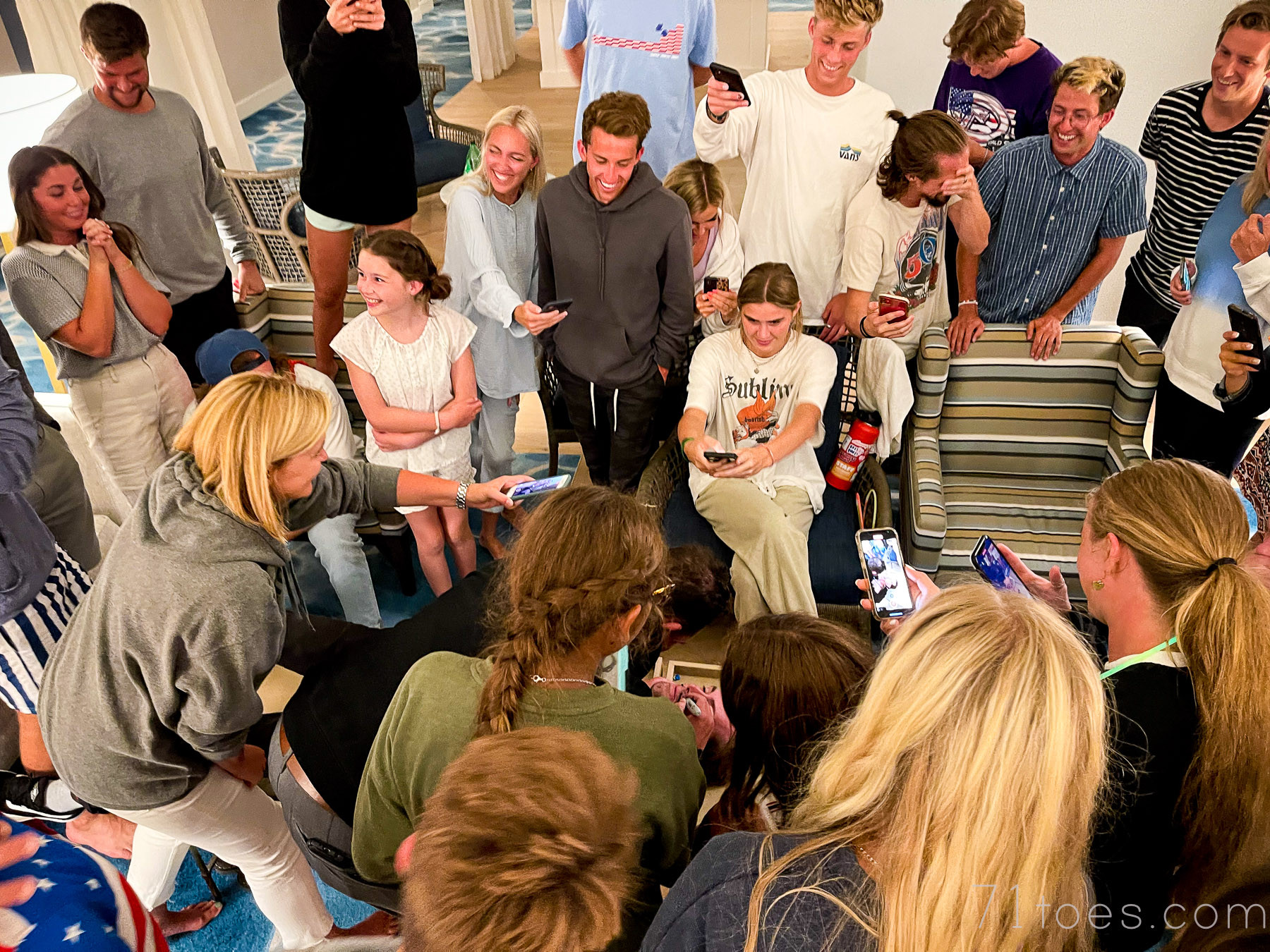
These games are just the beginning! With a little planning and enthusiasm, you can make your family reunion an unforgettable experience filled with laughter, connection, and joyful competition. So gather your family, choose your games, and get ready to create some lasting memories!
Explore More Game Ideas:
Plan Your Perfect Reunion:
- How to Create an Awesome Family Reunion
